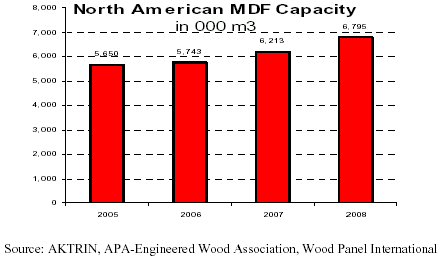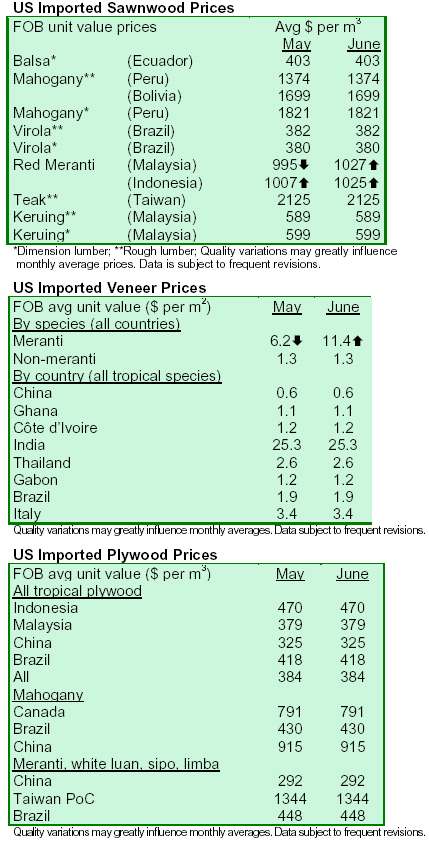|
North American MDF capacity to grow marginally
The capacity of Medium Density Fibreboard (MDF) in North America grew at a very slow pace
last year from 5.6 million m3 to 5.7 million m3. This is a mere 1.6% and amounts to less than
100,000 m3. As no new mills came on stream, virtually all of this increase came in the form of
a few mill renovations.
In spite of the stagnant capacity situation, the industry is not standing still. Several noteworthy
ownership changes took place recently or are in the negotiating stage.Flakeboard America has
acquired three Weyerhaeuser mills, providing the company with over 1.2 million m3 of
capacity, or 21% of the North American total. At the end of 2006, Roseburg Forest Products, the largest
overall composite panel producer in North America, purchased Georgia Pacificí»s Holly Hill mill.
The origin of the Holly Hill mill goes back to the mid-1970s. As such, it is one of
the oldest MDF mills in North America but it has since been upgraded. Georgia Pacific still retains its thin MDF
operation in Monticello.

The capacity growth in the North American MDF industry was only marginally higher this year
but it will likely accelerate a bit next year. In 2007, new installations added
about 8.2% to capacity to reach approximately 6.2 million m3 up from 5.7 million m3 the year before. Next
year, capacity is predicted to advance by about 9.3% or slightly in excess of one-half million m3 to a total of
approximately 6.8 million m3.
Overall, the past and anticipated future volume growth between 2005 and 2008 is fairly modest
at just slightly above one million m3. Nevertheless, the prolonged and uninterrupted positive
growth rate is a rare occurrence in the North American MDF industry.
A few noteworthy companies undertook new capital investments last year or are planning to do
so in the near future. Kronotex in Barnwell, SC recently added about 8% or 440,000 m3 to its
MDF capacity raising it slightly above 6.2 million m3. In 2008, the Kronospan plant in
Eastaboga, AL will produce commercial board and add a further 300,000 m3 to capacity. The
press is configured for lengthening at a later date, with the possibility of a further
120,000 m3.
The installation of a line at ATC Moncure is also due to start up soon with a capacity increase in excess of 200,000
m3. Industrias Emman de Ocotlan will also open a new mill in Mexico next year. The company already operates a
small particleboard facility and has bought a 45,000 m3/year line from Shanghai Wood Based Panel Machinery
Co. Ltd.
The North American MDF industry is also progressing by way of shifting its production towards
higher value-added products. Almost all of North American MDF mills intend
to increase their volumes of non-standard or added-value grades. The growth of such products amounted to an
estimated 24% in 2007, which may result in an even higher growth rate in the 27% range.
Currently, nonstandard output represents about 14% and may rise to as high as 20% in 2008.
Laminate flooring is undoubtedly the brightest prospect for the North American MDF industry.
This applies in particular to ATC (Shippenville and Moncure),Flakeboard, Unilin (Mt. Gilead), and SierraPine
(Medford).
It is interesting to note that North American mills which are not engaged already, or only to a
limited extent, in flooring substrate production do not plan to increase theirinvolvement in the
near future. The companies do not possess appropriate presses or doní»t have spare capacity
and seem to be afraid to compete against newer specialized flooring facilities that have recently
been installed.
Other forms of new non-standard MDF being developed and coming on the market include
lightweight panels, building boards, overlaid boards, and higher performance
boards (using low formaldehyde resins). In response to new environmental requirements SierraPine has developed
í«Sustainable Design Fibreboardí» (SDF), which is an innovative new grade of environmentally
friendly fibreboard.
Apart from laminate flooring, the future of the MDF industry in North America is full of
challenges, largely as a result of the weak housing market. Residential construction is 20%
below 2006 levels and it is not likely that an improvement will happen before mid-2008.
Rising imports of secondary wood products from China and other low costs countries also have
a detrimental impact on the North American production of furniture,
mouldings, and other secondary wood products. The low value of the US-dollar is mitigating the problem only to a
minor extent. In an environment of fierce international competition, Canadian and other foreign
mills exporting to the USA are usually absorbing the exchange losses themselves, rather than
losing the sale to a competitor. Last but not least, the MDF industry has to grapple with
expensive and ever stiffer environmental regulations (MACT and CARB) ĘC above all in California.
The North American demand for í░commodity-likeí▒ MDF is likely to grow only by about 2% this
year and only marginally faster in 2008. This is slower than the new
capacity growth and responsible for the oversupply of MDF. In view of this situation, MDF prices may remain
soft. To make matters worse, the MDF industry is suffering rising input costs. Experts are hopeful that
market conditions will improve next year allowing prices to rebound a bit in the second half of
2008. As mentioned above, companies specializing in higher-value-added products are doing
better.

íí
íí
|